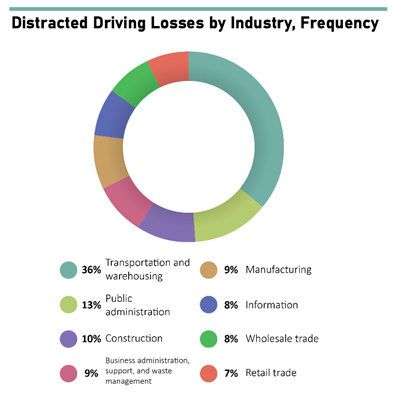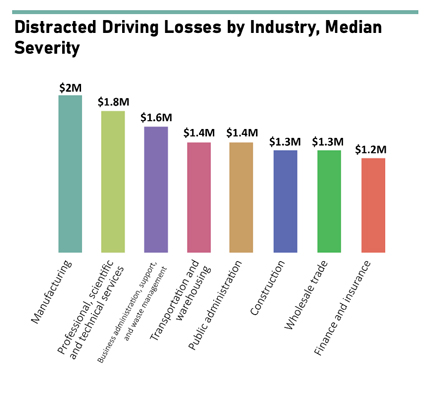Distracted driving refers to any activity that pulls a driver’s focus from the road. Such activities may include talking or texting on the phone, eating or drinking, talking to passengers, and adjusting the stereo or navigation system. In 2020, the National Highway Traffic Safety Association reported 3,142 deaths caused by distracted driving. Considering these findings, it’s clear that distracted driving poses a risk to everyone on the road.For organizations that depend upon employees to drive, distracted driving losses are a serious concern. According to the Centers for Disease Control and Prevention, people who drive for work are more likely to be in a hurry to reach their destinations, think about work tasks, experience fatigue or use their cellphones on the road. Read on for a glimpse into Advisen’s distracted driving data and guidance on how to keep employees safe behind the wheel.
Types of Distracted Driving
According to the National Institute for Occupational Safety and Health, there are three primary types of distractions drivers may encounter on the road. These distractions include:
- Visual distractions—Anything that takes a driver’s eyes off the road is a visual distraction. This includes reading text messages, glancing at directions or turning to look at accidents.
- Manual distractions—These distractions include anything that causes a driver to take their hands off the wheel, such as reaching for something in the vehicle, adjusting the radio, eating or drinking.
- Cognitive distractions—A driver whose mind isn’t on the road is cognitively distracted. These distractions can include talking on the phone, chatting with a passenger or thinking about topics other than driving behind the wheel.
Any type of distracted driving is dangerous and can result in serious accidents or injuries.
Advisen Data
Advisen’s loss database contains numerous vehicular losses describing accidents related to distracted driving. Here’s a look at distracted driving losses by industry.
Distracted Driving Losses by Industry, Frequency
The transportation and warehousing industry accounts for the largest proportion of distracted driving losses in Advisen’s database at 36%. The public administration, construction, administration, support and waste management sectors also contain a high percentage of distracted driving losses, according to Advisen data.
Distracted Driving Losses by Industry, Median Severity
Distracted driving losses can be costly. Advisen data shows the median cost of a distracted driving loss ranges from $1.2 million to $2 million across top industries. The manufacturing sector has the highest median distracted driving loss cost across all industries.
Loss ExamplesThe cost of a distracted driving loss can vary greatly based on a number of factors. Here are some examples of costly losses in Advisen’s database:
- In 2017, a truck driver for AJD Business Services Inc., crashed into the back of a row of stopped traffic and killed an 18-year-old boy. The truck driver was distracted by his cellphone and didn’t attempt to brake until seconds before the crash. A jury awarded the plaintiff $900 million in punitive damages and $16 million in compensatory damages.
- In 2015, a bus driver crashed into a 35-year-old woman, leaving her with serious injuries. The plaintiff alleged the driver was talking on the phone at the time of the accident and that the driver’s company failed to enforce cellphone policies and speeding The jury found the company guilty of negligence and comparative responsibility. The plaintiff received $45 million for her injuries.
Federal and State LawsMost states have laws that ban texting while driving. A growing number of states have also banned the use of handheld devices behind the wheel.At the federal level, The Federal Motor Carrier Safety Administration prohibits commercial motor vehicle drivers from sending or reading texts, or otherwise using handheld devices while driving. Drivers who fail to comply with these standards may face fines or disqualifications, in addition to the risk of causing deadly accidents.
PreventionIn order to reduce distracted driving losses, employers should consider the following prevention measures:
- Create a distracted driving policy. Ban the use of handheld devices while driving. Other distracting activities such as eating, grooming and reading should also be prohibited.
- Use technology. Consider installing phone-blocking technology within vehicles. It may also be valuable to implement technology that can detect and warn drivers when they are distracted.
- Communicate policies to employees. Any changes about the types of technology being used in vehicles should be clearly communicated to employees. Ensure cellphone policies and other distracted driving policies are clearly written and accessible for all drivers.
- Lead by example. Managers should clearly communicate the message that answering emails and texts are not as important as driving safely. Ask managers to refrain from texting or calling employees behind the wheel.
ConclusionDistracted driving is an all too frequent occurrence that poses costly risks for employers. By understanding these risks and implementing proper prevention measures, employers can help mitigate distracted driving losses and keep their employees safe on the road. For more information on creating safe driving policies, contact us today.
This article should be used for informational purposes only and should not be considered financial advice. © 2022 Zywave, Inc. All rights reserved. Advisen’s loss data is curated from a wide variety of public sources. Our collection efforts focus on larger and more significant cases. For this reason, the figures in this article may not be fully representative of all cases of this type.  The transportation and warehousing industry accounts for the largest proportion of distracted driving losses in Advisen’s database at 36%. The public administration, construction, administration, support and waste management sectors also contain a high percentage of distracted driving losses, according to Advisen data. Distracted Driving Losses by Industry, Median Severity
The transportation and warehousing industry accounts for the largest proportion of distracted driving losses in Advisen’s database at 36%. The public administration, construction, administration, support and waste management sectors also contain a high percentage of distracted driving losses, according to Advisen data. Distracted Driving Losses by Industry, Median Severity Distracted driving losses can be costly. Advisen data shows the median cost of a distracted driving loss ranges from $1.2 million to $2 million across top industries. The manufacturing sector has the highest median distracted driving loss cost across all industries.Loss ExamplesThe cost of a distracted driving loss can vary greatly based on a number of factors. Here are some examples of costly losses in Advisen’s database:
Distracted driving losses can be costly. Advisen data shows the median cost of a distracted driving loss ranges from $1.2 million to $2 million across top industries. The manufacturing sector has the highest median distracted driving loss cost across all industries.Loss ExamplesThe cost of a distracted driving loss can vary greatly based on a number of factors. Here are some examples of costly losses in Advisen’s database:
